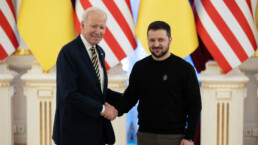It’s not enough for Washington to urge talks from behind the scenes, while insisting in public that only Kyiv can negotiate.
by Anatol Lieven, Responsible Statecraft
It is now clear that the Ukrainian offensive of the summer and fall of 2023 has failed, with minimal gains and enormous losses. There has been no repeat of the sweeping Ukrainian victories of 2022. Ukrainian army chief General Valery Zaluzhny has admitted that the war has now entered a stalemate.
Russia is now attacking in its turn; and although so far its forces also have made only very slow progress, time does not appear to be on Ukraine’s side. Russia has some four times Ukraine’s population and 14 times its GDP, which give it huge advantages in what has become a war of attrition. Serious imbalances in the U.S. and European military industries mean that Russia is also producing far more shells than Ukraine is receiving from the West.

Ukraine’s victories in the first months of the war were due to the courage and grit of Ukrainian soldiers, certain particularly effective Western weapons, and extremely bad Russian planning. They were also, however, attributable to the fact that Ukraine was able to mobilize more men than Russia, due to President Putin’s hesitation over increasing conscription. That advantage has now been reversed.
Moreover, as recent developments in the U.S. Congress and in Europe make clear, there can be no guarantee that Western aid will continue at levels sufficient to allow Ukraine to continue the fight successfully.
Recent Posts
‘Unconstitutional. Unethical. Authoritarian.’ ICE Bars Millions Of Immigrants From Bond Hearings
July 18, 2025
Take Action Now One watchdog said the new policy “seems like a blatant attempt to stop them from exercising their right to due process.”……
Americans Are Not Nearly Alarmed Enough About Climate Change
July 18, 2025
Take Action Now Americans still don’t comprehend how imminent, dangerous, and far-reaching the threat is—and journalists are partly to blame.By…
The IRS Is Building A Vast System To Share Millions Of Taxpayers’ Data With ICE
July 17, 2025
Take Action Now ProPublica has obtained the blueprint for the Trump administration’s unprecedented plan to turn over IRS records to Homeland Security…
Israel’s Sudden Assault On Syria Is Unchecked Aggression
July 17, 2025
Take Action Now Jerusalem is bombing Damascus and threatening al-Sharaa’s rule, while Washington was hoping to help the nascent government on…




